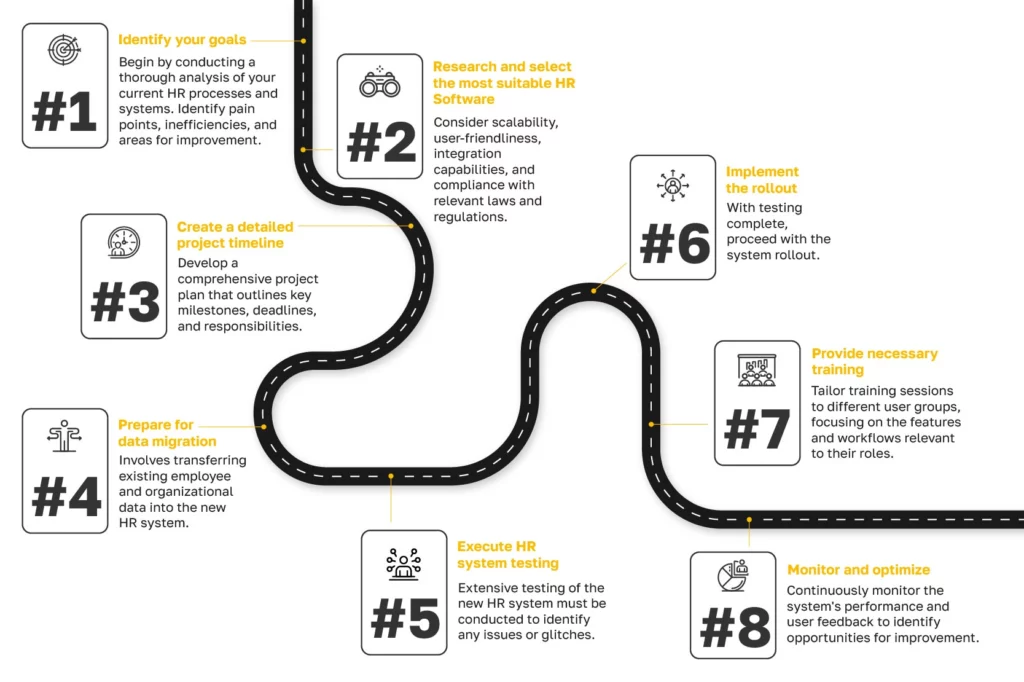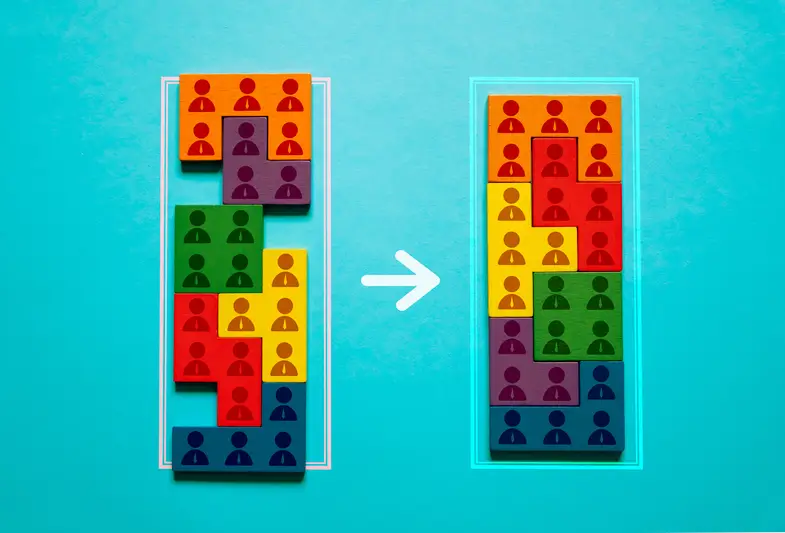Are you looking for a transformative approach to streamline your HR operations? Are you tired of wrestling with outdated systems and cumbersome processes, hoping for a more integrated and efficient way to manage your human resources? Being drowned in inefficiency can leave even the most dedicated professionals feeling drained and unmotivated.
We’ve all been in situations where the old ways of doing things just don’t cut it anymore. That’s where HR software implementation comes in. And with our experience improving HR processes with technology, we’re here to guide you through the entire approach.
Table of Contents
What Is HRIS Implementation?
HRIS implementation involves systematically integrating a chosen HR software into an organization’s HR operations. It’s a strategic approach that encompasses planning, execution, and maintenance phases to optimize HR functions and align them with the organization’s goals.
How Can HRIS Contribute to Company Success?
HRIS is crucial in automating routine tasks, reducing errors, improving compliance, and providing strategic insights through data analytics. This leads to increased productivity and better employee engagement, ultimately contributing to the company’s overall success.
8 Steps to a Successful Software Implementation Plan
HR software implementation demands a detailed approach to reach success. By breaking down the implementation process into manageable stages, organizations can precisely navigate the complexities.
Below is an eight-step plan to ensure a smooth transition to your new HR system:

#1 – Identify your goals
Begin by conducting a thorough analysis of your current HR processes and systems. Identify pain points, inefficiencies, and areas for improvement. Establish clear objectives for what you want your new HRIS to achieve, such as improved data management, enhanced recruitment processes, or more efficient payroll administration.
#2 – Research and select the most suitable HR Software
Consider scalability, user-friendliness, integration capabilities, and compliance with relevant laws and regulations. Prioritize software that best fits your identified goals, and don’t hesitate to request demos or trials to see the systems in action.
#3 – Create a detailed project timeline
Develop a comprehensive project plan that outlines key milestones, deadlines, and responsibilities. This timeline should include phases for system customization, data migration, testing, and training, ensuring that every implementation stage is accounted for and the project stays on track.
#4 – Prepare for data migration
Data migration is a critical step that involves transferring existing employee and organizational data into the new HR system. Begin by cleansing your current data to ensure accuracy. Then, work closely with your software provider to understand the best practices for a smooth and secure data transfer.
#5 – Execute HR system testing
Before the full rollout, extensive testing of the new HR system must be conducted to identify any issues or glitches. This phase should involve real-world scenarios and end-user input to ensure the system’s functionality meets your company’s needs. Address any concerns promptly to avoid future disruptions.
#6 – Implement the rollout
With testing complete, proceed with the system rollout. Consider a phased approach to mitigate risk and make the transition more manageable for your HR team. Communicate clearly with all stakeholders about the changes and provide support to address any initial challenges.
#7 – Provide necessary training
Comprehensive training is essential to ensure your team can use the new HR system effectively. Tailor training sessions to different user groups, focusing on the features and workflows relevant to their roles. Ongoing support and resources will help address any post-implementation questions or issues.
#8 – Monitor and optimize
The implementation process doesn’t end with the rollout. Continuously monitor the system’s performance and user feedback to identify opportunities for improvement. Regularly review whether the HRIS meets your business needs and make adjustments as necessary to maximize its value to your company.

How Long Does It Take to Implement HRIS on Average?
The duration of an HRIS implementation depends on the expertise and approach of those at the helm. When led by experienced professionals who understand how such HR systems operate, the process can be efficient. However, it can become seemingly endless in the hands of those less acquainted with the complexities of HR software.
What Are the Challenges of HRIS Implementation?
Implementing an HRIS system can be challenging. Anticipating the challenges of this software development outsourcing trend and planning accordingly can mitigate risks and ensure a smoother implementation.
Here are four common challenges found in the HRIS implementation process:
#1 – Customization complexity
There is usually a need to tailor the system to unique workflows, processes, and regulatory requirements. It can be time-consuming and technically challenging, potentially leading to delays and increased costs.
To mitigate this challenge, it’s crucial to define your customization needs thoroughly. Prioritize these needs based on their impact on your operations, and consider adopting a phased approach to customization, starting with the most critical functionalities. Collaboration with your HRIS provider when outsourcing software development for customization advice and support can streamline the process.
#2 – Training and support
Delivering practical training and support can be difficult due to varying user roles and technological proficiencies. Without adequate training, users may not fully use the system’s capabilities, undermining its potential benefits.
Developing a multifaceted training program that caters to different learning styles and roles within the organization can address this challenge. This could include a combination of in-person workshops, online tutorials, and reference materials. Additionally, establishing a dedicated support team to provide ongoing assistance and address user queries can enhance user confidence and system adoption.
#3 – Cost overruns
Extensive project timelines, additional customization requirements, unforeseen technical challenges, and straining allocated budgets and resources can lead to unexpected expenses.
Adopting a detailed and realistic budgeting approach is essential to navigating financial challenges. Include contingencies for unexpected expenses, and regularly review and adjust the budget as the project progresses. Engaging with an experienced HRIS vendor can also provide insights into potential costs and help optimize the budget.
#4 – Maintaining compliance
Non-compliance and a lack of data integrity can lead to legal complications and financial penalties, making it vital to incorporate compliance features within the HRIS from the very beginning.
To ensure compliance, organizations should adopt HRIS software that offers flexibility to adapt to legal changes. Regularly updating the system to align with new regulations and involving legal or compliance experts in the implementation process can ensure that the HRIS remains an asset rather than a liability.
What Can HR Teams Do to Prepare for HRIS Implementation?
HR teams should focus on thorough planning to prepare for human resource information system implementation. Involve key stakeholders in the decision-making process, ensure clear communication, and allocate adequate resources for training and support. Other recommendations include:
- Conduct a needs assessment: Analyze current HR processes to identify gaps or inefficiencies and determine what features are needed in the HRIS to address these issues.
- Develop a clear implementation plan: Create a detailed plan that includes data migration strategies, system testing phases, and contingency plans for potential challenges.
- Focus on data security and compliance: Work closely with the IT department and the HRIS vendor to ensure that the system complies with data protection regulations and industry standards.

We Can Help You Achieve an Effective HR Software Implementation!
Implementing HR software can feel like an uphill battle, which is why the expertise of a seasoned software development service provider becomes invaluable. A reliable HR software provider brings the technical skills required for seamless integration and the change performance management expertise to ensure smooth adoption across your organization.
At WillDom, our distinguished approach, centered on innovation and adaptability, positions us uniquely to address your HR software implementation needs. Our team of HR professionals is committed to delivering solutions that exceed your expectations, ensuring your HR system is robust, compliant, and perfectly aligned with your organizational goals.
Contact WillDom today and take the first step toward a more efficient HRIS implementation strategy!

